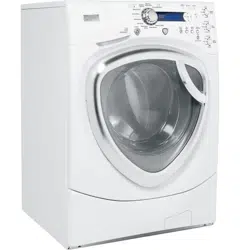Documents: Go to download!
User Manual
- User Manual - (English, French, Spanish)
- Quick Specs - (English)
- Energy Guide - (English)
- Operating Instructions
- Troubleshooting Tips
Table of contents
User manual Washer
Operating Instructions
About the washer control panel.
You can locate your model number on a label on the side of the washer.
WARNING! To reduce the risk of fire, electric shock, or injury to persons, read the IMPORTANT SAFETY INSTRUCTIONS before operating this appliance.
Quick Start
If the screen is dark, press the POWER button to “wake up” the display.
1. Press the POWER button.
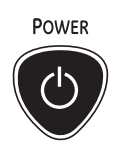
2. Select a wash cycle or Steam Refresh cycle. (Defaults are set for each cycle. These default settings can be changed. See Control settings for more information.)
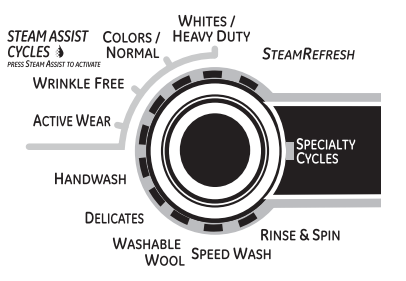
3. If you selected a cycle other than the SPECIALTY CYCLE, press the START/PAUSE button.

If you selected SPECIALTY CYCLE, choose between Drain & Spin, Garments, Bed and Bath, Other Specialty and Basket Clean for your specific needs before pressing START/PAUSE. See Specialty Cycles for more information.
WPDH8900J, WPDH8910K – Profile HA Steam Washer w/ SmartDispense™

WPDH8850J – Profile HA Steam Washer
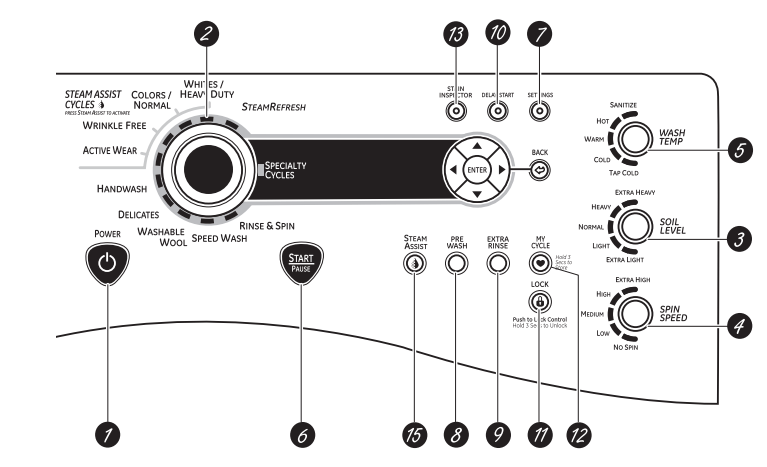
1. Power
Press to “wake up” the display. If the display is active, press to put the washer into standby mode.
NOTE: Pressing POWER does not disconnect the appliance from the power supply.
2. Wash Cycles
The wash cycles are optimized for specific types of wash loads. The chart below will help you match the wash setting with the loads. The GentleClean™ lifters lightly tumble the clothes into the water and detergent solution to clean the load.
WHITES/ HEAVY DUTY
For heavily to lightly soiled white cottons, household linens, work and play clothes. Can use the STEAM ASSIST option with this cycle.
COLORS/NORMAL
For heavy to lightly soiled colorfast cottons, household linens, work and play clothes. Can use the STEAM ASSIST option with this cycle.
WRINKLE FREE (PERMA PRESS)
For Easy Care and permanent press items. Can use the STEAM ASSIST option with this cycle.
ACTIVE WEAR
For active sports, exercise and some casual wear clothes. Fabrics include modern technology finishes and fibers such as spandex, stretch and micro-fibers. Can use the STEAM ASSIST option with this cycle.
STEAM REFRESH
To de-wrinkle 1 to 5 cotton blend items. This is not a wash cycle, but a cycle that applies only steam to the garments. Select the correct number of garments using the arrow keys and press ENTER.
The washer will beep upon completion of the cycle, and will continue to tumble for 30 minutes to keep wrinkles from setting in. Press START/PAUSE to remove clothes.
If clothes are slightly damp after completion of the cycle, hang dry clothes for 5 minutes before wearing.
HANDWASH
For items labeled hand-washable with light soils. Provides gentle rocking to mimic the handwashing action.
DELICATES
For lingerie and special-care fabrics with light to normal soil. Provides gentle tumbling and soak during wash and rinse.
WASHABLE WOOL
For the washing of machine washable wool products, provided that they are washed according to the instructions on the garment label. When selecting this cycle, you must use a detergent suitable for washing wool.
SPEED WASH
For lightly soiled items that are needed in a hurry. Cycle time is approximately 30 minutes, depending on selected options.
RINSE & SPIN
To quickly rinse out any items at any time.
SPECIALTY CYCLES
For unique garments that may need special treatment.
3. Soil Level
Changing the SOIL LEVEL increases or decreases the wash time to remove different amounts of soil.
To change the SOIL LEVEL, press the SOIL LEVEL button until you have reached the desired setting. You can choose between Extra Light, Light, Normal, Heavy or Extra Heavy soil.
4. Spin Speed
Changing the SPIN SPEED changes the final spin speed of the cycles. Always follow the garment manufacturer’s care label when changing the SPIN SPEED.
To change the SPIN SPEED, press the SPIN SPEED button until you have reached the desired setting. You can choose between No Spin, Low, Medium, High or Extra High Spin. Higher spin speeds are not available on certain cycles, such as Delicates.
Higher spin speeds remove more water from the clothes and will help reduce dry time, but may also increase the possibility of setting wrinkles on some fabrics.
5. Wash Temp
Adjust to select the proper water temperature for the wash cycle. The prewash and rinse water is always cold to help reduce energy usage and reduce setting of stains and wrinkles.
Follow the fabric manufacturer’s care label when selecting the wash temperature.
To change the wash temperature, press the WASH TEMP button until you have reached the desired setting. You can choose between Tap Cold, Cold, Warm, Hot or Sanitize. The Sanitized wash temperature is not available on certain cycles, such as Delicates.
When selecting the Sanitize wash temperature, the washer increases the water temperature to sanitize and kill more than 99% of many common bacteria found in home laundry. The sanitize wash temperature is only available on the Whites/Heavy Duty wash cycle. For best results, select the heavy soil setting when using the Sanitize wash temperature setting.
NOTE: The first 10 seconds of the wash fill is always cold. This feature assists in conditioning the fabric and preventing stains from setting on garments.
6. START/PAUSE
Press to start a wash cycle. If the washer is running, pressing it once will pause the washer and unlock the door. It will take a few seconds for the door to unlock after pressing PAUSE. Press again to restart the wash cycle.
NOTE: If the washer is paused and the cycle is not restarted within 15 minutes, the current wash cycle will be cancelled.
NOTE: In some cycles the washer will drain first, then unlock the door when it is paused.
NOTE: The washer performs automatic system checks after pressing the START button. Water will flow in 45 seconds or less. You may hear the door lock and unlock before water flows; this is normal.
7.

Settings
Use the SETTINGS button to adjust the following features:
Dryer Link:
Press the SETTINGS button. When “DRYER LINK” appears in the display, press ENTER. Using the  arrow keys, select ON and press ENTER.
arrow keys, select ON and press ENTER.
When the washer cycle is completed, the washer will communicate with the dryer when any button on the control panel is touched or the door is opened.
The washer will display, “TRANSFERRING CYCLE INFORMATION TO THE DRYER” and the dryer will display, “RECEIVING CYCLE INFORMATION TO THE DRYER”.
The dryer will only communicate with the washer if the dryer is not running a cycle.
If the washer starts a new cycle before the dryer has a chance to communicate with it, the information will be lost.
End-of-Cycle Volume:
Press the SETTINGS button. When “VOLUME” appears in the display, press ENTER, then select “End of Cycle”. Using the  arrow keys, select High, Medium, Low or Off.
arrow keys, select High, Medium, Low or Off.
Control Sounds:
Press the SETTINGS button, then select “Volume”. When “CONTROL SOUNDS” appears in the display, press ENTER. Using the  arrow keys, select High, Medium, Low or Off.
arrow keys, select High, Medium, Low or Off.
Display Brightness:
Press the SETTINGS button. When “DISPLAY BRIGHTNESS” appears in the display, press ENTER. Using the  arrow keys, select High, Medium or Low.
arrow keys, select High, Medium or Low.
Water Hardness
(Only appears when SMART DISPENSER Pedestal Accessory is connected to washer):
This will adjust the amount of detergent dispensed automatically for the SMART DISPENSER. See the Owner’s Manual supplied with the SMART DISPENSER for instructions for use.
8.

Prewash
Prewash is an extra wash before the main wash. Use it for heavily soiled clothes or for clothes with a care label that recommends prewashing before washing. Be sure to add high-efficiency detergent, or the proper wash additive to the prewash dispenser.
The prewash feature will fill the washer (adding the prewash detergent), tumble the clothes, drain and spin. Then the washer will run the selected wash cycle.
NOTE: In some special cycles, the prewash is selected automatically as the default. You can modify this selection at any time.
9.

Extra Rinse
Use an extra rinse when additional rinsing is desired to remove excess dirt and detergent from soiled loads.
NOTE: In some special cycles, the extra rinse is selected automatically as the default. You can modify this selection at any time. Some cycles have additional rinses done automatically.
10.

Delay Start
You can delay the start of a wash cycle for up to 24 hours. Press the DELAY START button to choose the number of hours you want to delay the start of the cycle. Use the ▲ and ▼ (up and down) arrows to find the desired delay time; then press ENTER to select the delay time. Finally, press the START button after the desired cycle is selected. The machine will count down and start automatically at the correct time.
NOTE: If you forget to fully close the door, a reminder signal will beep reminding you to do so.
NOTE: If you open the door when the delay is counting down, the machine will enter the pause state. You must close the door and press START again in order to restart the countdown.
11.

Lock
You can lock the controls to prevent any selections from being made. Or you can lock or unlock the controls after you have started a cycle.
Children cannot accidentally start the washer by touching pads with this option selected.
To lock the washer, press and hold the LOCK button for 3 seconds.
To unlock the washer controls, press and hold the LOCK button for 3 seconds. A sound is made to indicate the lock/unlock status.
The control lock icon on the display will light up when it is on.
NOTE: The POWER button can still be used when the machine is locked.
12.

MY CYCLE (on some models)
To save a favorite cycle, set the desired settings for wash cycle, soil level, spin speed and wash temp settings and hold down the MY CYCLE button for 3 seconds. A beep will sound to indicate the cycle has been saved.
To use your custom cycle, press the MY CYCLE button before washing a load.
To change the saved cycle, set the desired settings and hold down the MY CYCLE button for 3 seconds.
NOTE: When using MY CYCLE, wash options cannot be modified after the cycle has been started.
NOTE: If you change wash options with MY CYCLE before starting the cycle, the MY CYCLE light will turn off and you will be returned to the base cycle.
13. Stain Inspector
The STAIN INSPECTOR feature allows you
to indicate what stains are on the garments in your load. This feature can be used with any wash cycle.
To use STAIN INSPECTOR:
1.Select the wash cycle.
2.Press the STAIN INSPECTOR button (the button will light up when it is on).
3.Check the wash instructions on your garment.
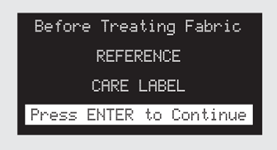
4.Press the ENTER button to continue.
5.Use the ▲ and ▼ arrows to find the desired stain category.
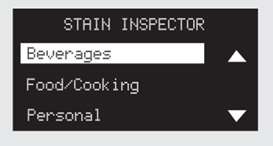
6.Press the ENTER button to select the stain category.
7.Use the ▲ and ▼ arrows to select the desired stain.

You have the following stains available to choose from:
OUTDOOR | COSMETICS | BEVERAGES | FOOD/COOKING |
Clay | Lipstick/Lip Balm | Grape Juice | Butter/Margarine |
Grass | Deodorant | Coffee/Tea | Cooking/Vegetable Oil |
Mud/Dirt | Lotions | Fruit Juice Other | Chocolate |
Rust Iron | Makeup (water-based) | Milk/Dairy | Tomato Based |
Tree Sap | Oil (hair/mineral) | Wine (red/white) | Barbecue Sauce |
PERSONAL | SCHOOL/OFFICE/HOME | LAUNDRY | OIL/GREASE/WAX |
Blood | Adhesive Tape | Dingy White Socks | Motor Oil/Lube |
Perspiration | Ballpoint Ink | Collar/Cuff Soil | Ointment/Salve |
Urine/Feces | Glue (white common) | Dye Transfer | Candle Wax |
Mouthwash | Pencil Mark | Fabric Softener | Crayon |
Vomit | Correction Fluid | Yellowing | Chapstick™ |
8.Press the ENTER button to select the stain.
9.Your selected stain will appear on the display.
10.Press the START button to start the cycle.
NOTE: To turn off STAIN INSPECTOR or to select a different stain, press the STAIN INSPECTOR button again.
NOTE: Prewash is selected automatically as the default for some stains. When selected automatically, the PREWASH button will light. For optimum stain removal, it is recommended to add high-efficiency detergent or proper wash additive to the prewash dispenser. You can turn off the prewash option if you do not want to add the prewash to the cycle.
14. SMART DISPENSE™ – optional accessory (on some models)
If you have purchased the PROFILE SMART DISPENSE System, refer to the Owner’s Manual that comes with the SMART DISPENSE System.
If you have not purchased the PROFILE SMART DISPENSE System, you will not have bulk-dispensing capability. If you select the SMART DISPENSE option, a message will be displayed advising that your unit does not have the capability. You should then put detergent and other selected additive in the flow- through dispenser drawer located at the top left of the unit. To purchase the PROFILE SMART DISPENSE System, go online to GEAppliances.com or contact your local retailer.
15. STEAM ASSIST
STEAM ASSIST adds steam into the washer during WHITES/HEAVY DUTY, COLORS/NORMAL, WRINKLE FREE or ACTIVE WEAR cycles.
To use:
1.Turn power ON and select a wash cycle.
The STEAM ASSIST option is only available on WHITES/HEAVY DUTY, COLORS/NORMAL, WRINKLE FREE or ACTIVE WEAR cycles.
2.Select the STEAM ASSIST button to activate Steam.
3.Press the START/PAUSE button.
About the washer features.
The Dispenser Drawer
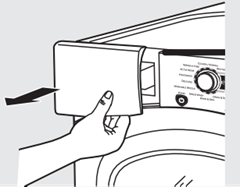
Slowly open the dispenser drawer by pulling it out until it stops.
After adding laundry products, slowly close the dispenser drawer. Closing the drawer too quickly could result in early dispensing of the bleach, fabric softener or detergent.
You may see water in the bleach and fabric softener compartments at the end of the cycle. This is a result of the flushing/siphoning action and is part of the normal operation of the washer.
Use only HE High-Efficiency detergent. 
The Prewash Compartment

- Only use the Prewash Compartment if you are selecting the Prewash cycle for heavily soiled clothes. Add measured detergent or prewash additive to the back left prewash compartment of the dispenser drawer.
- Detergent or prewash additive is flushed from the dispenser in the prewash cycle (if selected).
NOTE: Liquid detergent will drain into the washer drum as it is added.
- Detergent usage may need to be adjusted for water temperature, water hardness, size and soil level of the load. Avoid using too much detergent in your washer as it can lead to over sudsing and leave detergent residue on the clothes.
The Detergent Compartment
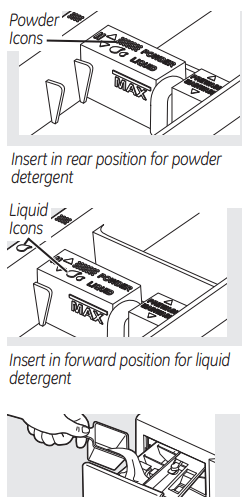
- Only use high-efficiency detergent in this washer. MAX line is for normal detergent. DO NOT fill above the MAX line.
DO NOT fill high-efficiency detergent to the MAX line. Use detergent manufacturer’s recommended amount.
The detergent selection insert must be placed in the detergent compartment in a specific position according to the type of detergent you are using.
- Powder Detergent – Place the insert in the rear position. The Powder Icons
 must line up on center when the insert is in the powder position.
must line up on center when the insert is in the powder position. - Liquid Detergent – Place the insert in the forward position. The Liquid Icons
 must line up on center when the insert is in the liquid position.
must line up on center when the insert is in the liquid position.
Move the insert by pulling it up and replace it by sliding it down between either the rear or front detergent compartment molded rails, as desired, for powder or liquid detergent. - Add measured detergent to the front left detergent compartment of the dispenser drawer.
- Detergent is flushed from the dispenser at the beginning of the wash cycle. Either powdered or liquid detergent can be used.
- Detergent usage may need to be adjusted for water temperature, water hardness, size and soil level of the load. Avoid using too much detergent in your washer as it can lead to oversudsing and detergent residue being left on the clothes.
- DO NOT put clumped detergent in the dispenser. Clumped detergent can cause a leak.
The Liquid Bleach Compartment

If desired, measure out the recommended amount of liquid bleach, not to exceed 1/3 cup (80 ml) and pour into the center compartment labeled “LIQUID BLEACH” marked with this symbol  .
.
It is recommended to use High-Efficiency (HE) bleach in this front-load washer.
Do not exceed the maximum fill line. Overfilling can cause early dispensing of the bleach which could result in damaged clothes.
NOTE: Do not use powdered bleach in the dispenser.
The Fabric Softener Compartment
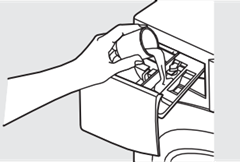
If desired, pour the recommended amount of liquid fabric softener into the compartment labeled “FABRIC SOFTENER.”
Use only liquid fabric softener in the dispenser.
Dilute with water to the maximum fill line.
Do not exceed the maximum fill line. Overfilling can cause early dispensing of the fabric softener, which could stain clothes.
NOTE: Do not pour fabric softener directly on the wash load.
Loading and using the washer.
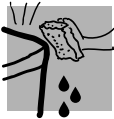 Care and Cleaning/General Maintenance
Care and Cleaning/General Maintenance
Exterior: Immediately wipe off any spills. Wipe with damp cloth. Do not hit surface with sharp objects.
Interior: Dry around the washer door opening, flexible gasket (including attached hoses) and door glass. These areas should always be clean to ensure a water-tight seal.
It is recommended to rinse the washer at least once per month with 1 cup of bleach (or other commercially available product manufactured for this purpose) poured into the prewash section of the dispenser (no clothes) using the BASKET CLEAN CYCLE (found in the SPECIALTY CYCLES menu). Check to ensure the steam nozzle is not clogged. Clean the nozzle if necessary.
Moving and Storage: Ask the service technician to remove water from drain pump and hoses. Do not store the washer where it will be exposed to the weather. When moving the washer, the tub should be kept stationary by using the shipping bolts removed during installation.
See Installation Instructions in this manual. If these parts are not available, they can be ordered by visiting our Website at GEAppliances.com or by calling 800.GE.CARES.
Long Vacations: Be sure water supply is shut off at faucets. Drain all water from hoses if weather will be below freezing.
Clean Pump Filter
Due to the nature of the front-load washer, it is sometimes possible for small articles to pass to the pump. The washer has a filter to capture lost items so they are not dumped to the drain. To retrieve lost items, clean out the pump filter.
1.Using a coin in the notch on the door, open the access door.
2.Place a shallow pan or dish under the pump access door and towels on the floor in front of the washer to protect the floor. It is normal to catch about a cup of water when the filter is removed.
3.Turn the pump filter counterclockwise and remove the filter.
4.Clean the debris from the filter.
5.Replace the filter and turn clockwise to the marked position.
6.Close the access door.

Cleaning the Door Gasket

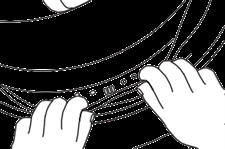
Open the washer door. Using both hands, press down the door gasket. Remove any foreign objects if found trapped inside the gasket. Make sure there is nothing blocking the holes behind the gasket.
While holding down the door gasket, inspect the interior gasket by pulling it down with your fingers. Remove any foreign objects if found trapped inside this gasket. Make sure there is nothing blocking the holes behind the gasket.
When you are finished cleaning the door gasket, remove your hands and the gaskets will return to the operating position.

Lock tab is visible only after drawer has been pulled out
Dispenser Drawer Area: Detergent and fabric softener may build up in the dispenser drawer. Residue should be removed once or twice a month.
- Remove the drawer by first pulling it out until it stops. Then reach back into the right rear corner of the drawer cavity and press down firmly on the lock tab, pulling out the drawer.

- Remove the insert from the bleach and fabric softener compartments and the detergent insert. Rinse the inserts and the drawer with hot water to remove traces of accumulated laundry products.
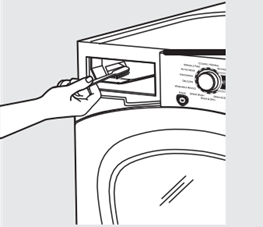
- To clean the drawer opening, use a small brush to clean the recess. Remove all residue from the upper and lower parts of the recess.
- Return inserts to the proper compartments. Replace the dispenser drawer.
- To reduce buildup in the Dispenser Drawer area:
Use only HE High-Efficiency detergent. 
 Fabric Care Labels
Fabric Care Labels
Below are fabric care label “symbols” that affect the clothing you will be laundering.
WASH LABELS

BLEACH LABELS

DETERGENT LABELS

Available accessories.
Pedestal
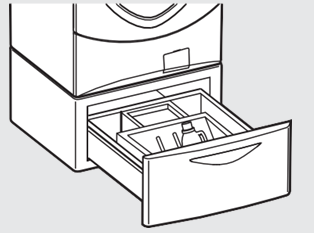
There is a pedestal available for your washer. This pedestal gives the washer more height and gives storage for your washing necessities. Included with the pedestal is a divider that allows you to store liquid laundry detergent out of sight. See the pedestal installation instructions.
Profile Smart Dispense System
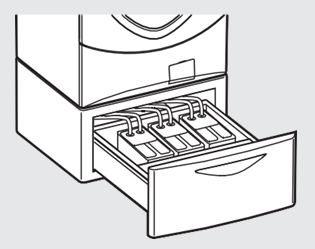
The Profile SMART DISPENSE System lets you store laundry detergent and fabric softener to be dispensed automatically during the wash and rinse cycles of this washer. NO BLEACH may be used in this dispense system. See the Owner‘s Manual that is included with the Profile SMART DISPENSE System for installation instructions.
Demand Response. (on some models)
Model WPDH8910 is compatible with the GE Demand Response (DR) module which can be purchased separately. Contact your local utility .
The following demand response features are available as part of a pilot test program with the local utility company to help consumers reduce peak electricity usage in the home.
INSTALLATION
The preferred location for the module installation is on top of the clothes dryer.
Details on how to connect the cables to the module are in the instructions that come with the module.
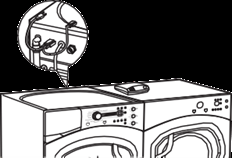
Wait 5 minutes; then press the Settings button. Scroll and look for the energy management screen as seen below.
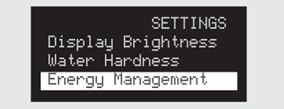
This screen means the module is attached correctly and you can begin to use your DR-enabled appliance following the instructions below.
If the Energy Management Screen is not available, refer to the DR module troubleshooting guide.
QUICK GUIDE
There are 4 power levels available: Critical, High, Medium and Low. On the Medium and Low levels, the unit runs as normal. The following steps show how the unit reacts during startup at Critical and High power levels.
Option 1 (Delay Eco)
During startups at Critical and High levels, the unit will delay starting until the level becomes Medium or Low. Press the START/PAUSE button.

Option 2 (Override Delay Eco)
To start the washer when Delay Eco is shown, press the DELAY START button to turn the delay off. Then press START/PAUSE to begin the wash.
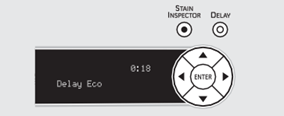
SETTINGS MENU
Press SETTINGS; then select Energy Management.
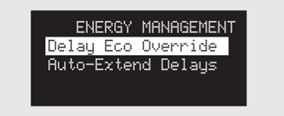
Delay Eco Override
If you are starting a cycle in a Critical or High utility rate, this option allows the unit to automatically run on an Eco Cycle. This setting will wash with less energy than normal cycles. The default setting is YES.
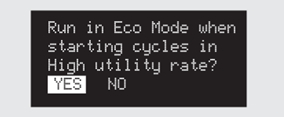
Auto-Extend Delays
If a timed delay is selected, this option allows for the scheduled start to extend if the utility rate is Critical or High at the scheduled start. The default setting will automatically extend these cycles.
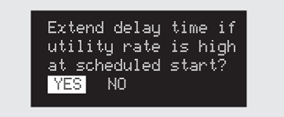
In order for the demand response features on the appliance to work, additional equipment is required to be installed to interface with the local utility. Such equipment may be sold separately and/or is available through your utility as part of the pilot test program. Check with your utility company to see if a pilot test program is available in your area and for full details.
PLEASE NOTE: At the conclusion of the pilot test program or if you move to an area where the program is not available, the demand response features cannot be activated and utilized on the appliance. The appliance will function as normal after the demand response equipment has been deactivated or disconnected.
Troubleshooting Tips
Before you call for service…
Troubleshooting Tips
Save time and money! Review the charts on the following pages first and you may not need to call for service.
Problem | Possible Cause | What To Do |
Not spinning or agitating | Drain hose is kinked or improperly connected | •Straighten drain hose and make sure washer is not sitting on it. |
Household drain may be clogged | •Check household plumbing. You may need to call a plumber. | |
Drain hose siphoning; drain hose pushed too far down the drain | •Ensure there is an air gap between hose and drain. | |
Washer pump filter may be clogged | •Clean Pump Filter – Open the pump access door (use a coin) and remove the pump filter by turning it counterclockwise and pulling out. Clean the filter, removing all loose debris, and put filter back in place. | |
Load is out of balance | •Redistribute clothes and run drain & spin or rinse & spin. •Increase load size if washing small load containing heavy and light items. | |
Leaking water | Door gasket is damaged | •Check to see if gasket is seated and not torn. Objects left in pockets may cause damage to the washer (nails, screws, pens, pencils). |
Door gasket not damaged | •Water may drip from the door when the door is opened. This is a normal operation. | |
Check back left of washer for water | •If this area is wet, you have oversudsing condition. Use less detergent. | |
Fill hoses or drain hose is improperly connected | •Make sure hose connections are tight at washer and faucets and make sure end of drain hose is correctly inserted in and secured to drain facility. | |
Household drain may be clogged | •Check household plumbing. You may need to call a plumber. | |
Not draining | Drain hose is kinked or improperly connected | •Straighten drain hose and make sure washer is not sitting on it. |
Household drain may be clogged | •Check household plumbing. You may need to call a plumber. | |
Drain hose siphoning; drain hose pushed too far down the drain | •Ensure there is an air gap between hose and drain. | |
Washer pump filter may be clogged | •Clean Pump Filter – Open the pump access door (use a coin) and remove the pump filter by turning it counterclockwise and pulling out. Clean the filter, removing all loose debris, and put filter back in place. | |
Not spinning | Drain hose is kinked or improperly connected | •Straighten drain hose and make sure washer is not sitting on it. |
Household drain may be clogged
| •Check household plumbing. You may need to call a plumber. | |
| Drain hose siphoning; drain hose pushed too far down the drain | •Ensure there is an air gap between hose and drain. | |
| Washer pump filter may be clogged | •Clean Pump Filter – Open the pump access door (use a coin) and remove the pump filter by turning it counterclockwise and pulling out. Clean the filter, removing all loose debris, and put filter back in place. | |
| Load is out of balance | •Redistribute clothes and run drain & spin or rinse & spin. •Increase load size if washing small load containing heavy and light items. | |
Motor is overheated
| •Washer motor will stop if it becomes overheated. It will automatically restart after a cool-down period of up to 2 hours (if washer has not been manually turned off). | |
| Door is open | •Make sure door is closed. |
Incomplete cycle or timer not advancing | Drain hose is kinked or improperly connected | •Straighten drain hose and make sure washer is not sitting on it. |
Household drain may be clogged | •Check household plumbing. You may need to call a plumber. | |
Drain hose siphoning; drain hose pushed too far down the drain | •Ensure there is an air gap between hose and drain. | |
Washer pump filter may be clogged | •Clean Pump Filter – Open the pump access door (use a coin) and remove the pump filter by turning it counterclockwise and pulling out. Clean the filter, removing all loose debris, and put filter back in place. | |
Automatic load redistribution | •Remaining time display has changed as the machine has redistributed the load once or twice. This is normal operation. Do nothing; the machine will finish the wash cycle. | |
Loud or unusual noise; vibration or shaking | Cabinet moving | •Washer is designed to move 1/4² to reduce forces transmitted to the floor. This movement is normal. |
All rubber leveling legs are not firmly touching the floor | •Push and pull on the back right and then back left of your washer to check if it is level. If the washer is uneven, adjust the rubber leveling legs so they are all firmly touching the floor. Your installer should correct this problem. | |
Unbalanced load | •Open door and manually redistribute load. To check machine, run rinse and spin with no load. If normal, unbalance was caused by load. | |
Whistling | •SteamAssist or SteamREFRESH is selected. This is normal operation for the selected steam modes. | |
Clothes too wet | Drain hose is kinked or improperly connected | •Straighten drain hose and make sure washer is not sitting on it. |
Household drain may be clogged | •Check household plumbing. You may need to call a plumber. | |
Drain hose siphoning; drain hose pushed too far down the drain | •Ensure there is an air gap between hose and drain. | |
Washer pump filter may be clogged | •Clean Pump Filter – Open the pump access door (use a coin) and remove the pump filter by turning it counterclockwise and pulling out. Clean the filter, removing all loose debris, and put filter back in place. | |
Load is out of balance | •Redistribute clothes and run drain & spin or rinse & spin. •Increase load size if washing small load containing heavy and light items. |
No power/washer not working or dead | Drain hose is kinked or improperly connected | •Straighten drain hose and make sure washer is not sitting on it. |
| Household drain may be clogged | •Check household plumbing. You may need to call a plumber | |
Drain hose pushed too far down the drain | •Ensure there is an air gap between hose and drain. | |
Washer pump filter may | •Clean Pump Filter – Open the pump access door (use a coin) and remove the pump filter by turning it counterclockwise and pulling out. Clean the filter, removing all loose debris, and put filter back in place. | |
Washer is unplugged | •Make sure cord is plugged securely into a working outlet. | |
| Water supply is turned off | •Turn both hot and cold faucets fully on. | |
Circuit breaker/fuse is tripped/blown | •Check house circuit breakers/fuses. Replace fuses or reset breaker. Washer should have separate outlet. | |
| Controls are not set properly | •Hold START/PAUSE button to start cycle. | |
Automatic self system checks | •First time the washer is plugged in, automatic checks occur. It may take up to 20 seconds before you can use your washer. This is normal operation. |
Water does not enter washer or enters slowly | Automatic self system checks | •After START is pressed, the washer does several system checks. Water will flow several seconds after START is pressed. |
Water supply is turned off | •Turn on both hot and cold faucets fully. | |
Water valve screens are stopped up | •Turn off the water source and remove the water connection hoses from the upper back of the washer. Use a brush or toothpick to clean the screens in the machine. Reconnect the hoses and turn the water back on. | |
Snags, holes, tears, rips or excessive wear | Pens, pencils, nails, screws or other objects left in pockets | •Remove loose items from pockets. |
Pins, snaps, hooks, sharp buttons, belt buckles, zippers and sharp objects left in pockets | •Fasten snaps, hooks, buttons and zippers. | |
Wrinkling | Improper sorting | •Avoid mixing heavy items (like work clothes) with light items (like blouses). |
Overloading | •Load your washer so clothes have enough room to move freely. | |
Incorrect wash cycle | •Match Cycle selection to the type of fabric you are washing (especially for easy care loads). | |
Repeated washing in water that is too hot | •Wash in warm or cold water. | |
Grayed or yellowed clothes | Not enough detergent | •Use correct amount of detergent. |
Not using HE (high-efficiency) detergent | •Use HE detergent. | |
Hard water | •Use hottest water safe for fabric. •Use a water conditioner like Calgon brand or install a water softener. | |
Water is not hot enough | •Make sure water heater is delivering water at 120°–140°F (48°–60°C). | |
Detergent is not dissolving | •Try a liquid detergent. | |
Dye transfer | •Sort clothes by color. If fabric label states wash separately, unstable dyes may be indicated. | |
Colored spots | Incorrect use of fabric softener | •Check fabric softener package for instructions and follow directions for using dispenser. |
Dye transfer | •Sort whites or lightly colored items from dark colors. •Promptly remove wash load from washer. | |
Water temperature is incorrect | Water supply is improperly connected | •Make sure hoses are connected to correct faucets. |
House water heater is not set properly | •Make sure house water heater is delivering water at 120°–140°F (48°–60°C). | |
Bad odor inside your washer | Washer unused for a long time or not using recommended quality of HE detergent | •Leave the door slightly open for the water to air dry. •Run a BasketClean cycle (found in the Specialty cycle Menu) with 1 cup of bleach. See the Care and Cleaning/ General Maintenance section. |
Slight variation in metallic color | This is normal | •Due to the metallic properties of paint used for this unique product, slight variations of color may occur due to viewing angles and lighting conditions. |
Door unlocks slowly | This is normal | •During SteamASSIST and SteamREFRESH, access to the tub is delayed to reduce exposure to steam. |
See other models: JGS750DEF4WW GLD5560L15SS PDS20MFWACC CTX16HABJRWW GTH18DBRKRWW
